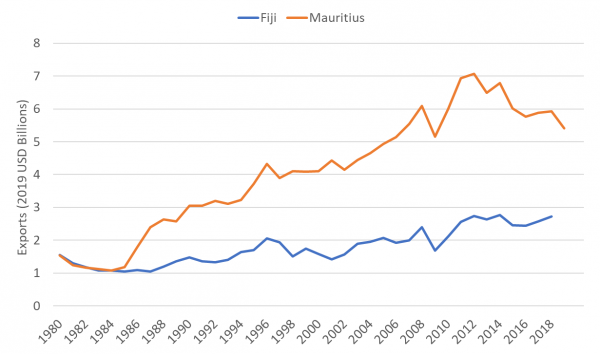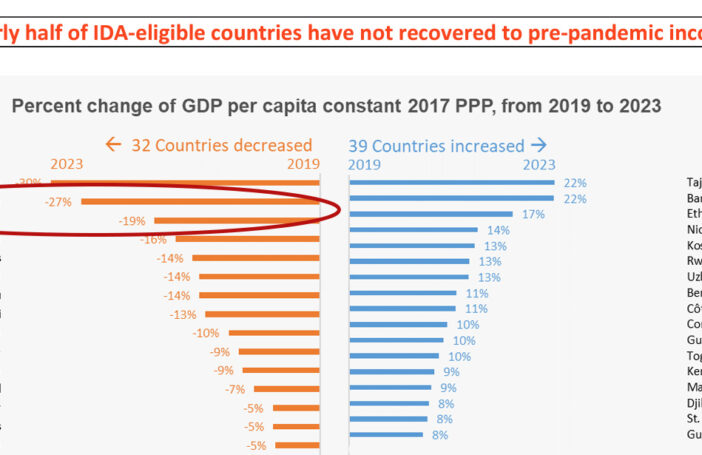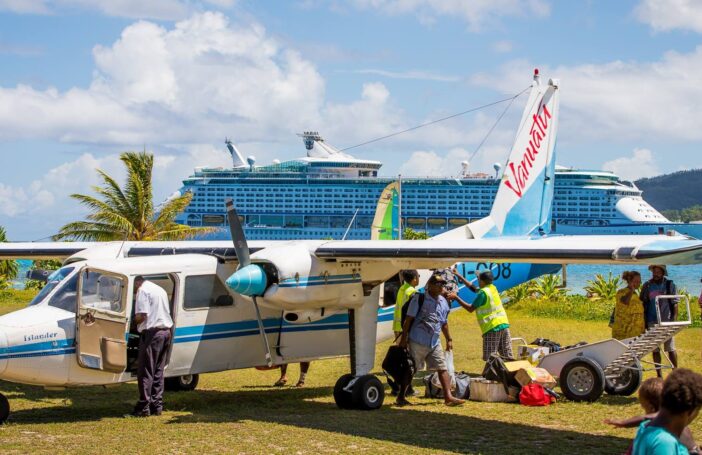Mauritius was recently declared by the World Bank to be a high-income country. On the other side of the globe, but with many similar characteristics, Fiji, which used to be richer than Mauritius, now has less than half the latter’s income per capita. The first in our two-blog series looked at Mauritius’s superior economic, social and political performance. This post tries to explain the huge differences observed.
Both countries were dominated by sugar cane farming in the past, and are reliant on tourism today. While Mauritius generates slightly more tourism dollars per capita than Fiji, its economy as a whole is less dependent on tourism. Since 1995, Fiji’s international tourism receipts as a proportion of total exports have consistently been higher than Mauritius’. Since 2010, the annual gap has been about 15 to 20 percentage points.
Figure 1: International tourism receipts trends

Mauritius’ lower reliance on tourism reflects the fact that its economy is more diversified than Fiji’s. Mauritius’ top exports in 2018 were: travel; textiles; and business, professional and technical services. These constituted 39%, 11% and 10% of total exports, respectively. On the other hand, Fiji’s top exports in the same year were heavily skewed towards travel, at 54% of total exports, with its next two biggest exports, bottled water and fish products, only representing 6% each.
Mauritius’ exports are not only more diversified; they have grown faster as well. As Figure 2 shows, Fiji’s and Mauritius’ inflation-adjusted exports were virtually the same in the first half of the 1980s. Since then, however, Mauritius’ exports have grown much faster – at least till around 2012. Its exports have been struggling since though: no doubt this is one reason why its growth has slowed (as shown in Figure 2 of the previous blog).
Figure 2: Exports of goods and services (in 2019 US$ billions)

As Figure 3 shows, Fiji and Mauritius had a very similar economic structure in the 1970s, the decade following independence. In 1976, both had a service sector that made up 47% of GDP, manufacturing at 11-13%, and agriculture at 20-24%. Now the two economies are very different. Agriculture is still 12% of GDP in Fiji, but only 3% in Mauritius. The share of manufacturing has changed little in either country. Mauritius has become a service-based economy, with the service sector now accounting for 67% of GDP, compared to just 54% in Fiji.
Figure 3: Fiji’s and Mauritius’ economies – value added of respective sectors as % of GDP

Mauritius has been particularly successful in developing competitive niches in the service sector. In 2019, the information and communications technology/business process outsourcing sector contributed 5.8% to its GDP.
Facilitating trade between Asia and Africa has also proven to be a successful strategy. According to Auty (p.271), Mauritius channelled about 40% of India’s inbound foreign direct investment during the 2000s through a slew of accommodative policies such as a double taxation treaty and favourable tax rates.
Underlying Mauritius’ superior economic performance is no doubt a better quality of governance. In a 2019 ranking of countries by ease of doing business produced by the World Bank, Mauritius ranked 13th while Fiji languished in 102nd spot. In the World Bank governance indicators (which cover about 210 countries), Fiji ranks slightly higher for control of corruption, but Mauritius ranks much higher for government effectiveness, regulatory quality, and rule of law.
Table 1: World Bank governance indicators: percentile rankings (best=100)
A deeper account would explain not only Mauritius’ economic success but also its better governance and its greater political stability and freedom (as shown in our first blog). Both Fiji and Mauritius are multi-ethnic societies. Economists Arvind Subramanian and Devesh Roy have argued (in chapter 8 of this book) that Mauritius’ ethnic diversity has been a strength, since it has forced the country into a moderate settlement, bound by the rule of law.
That argument doesn’t stack up well in the comparison with Fiji. From that perspective, Mauritius has benefited rather by the clear numerical dominance in that country of one ethnic group, the Indo-Mauritians, who make up some two-thirds of the country’s population.
Fiji by contrast has been wracked by tensions between its two main ethnic groups, and by the process of one group asserting itself over the other. Ethnic conflict has also been more intense in Fiji because one group is indigenous, the iTaukei, and the other group, the Indo-Fijians, started arriving in the late 1800s. Mauritius was uninhabited until 1638 when it was first colonised.
There were about the same number of iTaukei and Indo-Fijians in the 1940s, and slightly more Indo-Fijians by the 1980s. The subsequent backlash against the latter group (the first three coups were directed against governments popular with Indo-Fijians) changed the country’s ethnic make-up as Indo-Fijians decided to leave. Indigenous Fijians are now once again safely in the majority. The last census in which ethnicity was recorded was in 2007, and it showed one-and-a-half times as many iTaukei as Indo-Fijians.
Is Fiji then becoming more like Mauritius? Certainly, there is now one dominant ethnic group in Fiji, but there is probably also greater ongoing polarisation. One interesting contrast is the very different marriage rates between ethnic groups in the two countries. We don’t have recent data on this, but it was estimated to be 0.9% in Fiji in the 1990s; and ten times higher at 8.8% in Mauritius in the late 1980s.
And then there is the damage done to institutions – the rule of law, democracy – in Fiji by the country’s four coups. This seems permanent or at least long term. Catching up with Mauritius – the country Fiji was once richer than, but is now twice as poor as – will not be easy. But Fiji would do well to aim to become more like Mauritius: economically more diversified, politically more free, and socially less polarised.
Notes
[1] Source for all figures: World Bank. Table 2 is from the World Bank Governance Indicators. It shows the percentile rank among all countries with 0 being the lowest and 100 the highest.
[2] To convert data for Figure 2 into 2019 USD terms, the nominal exchange rate was used to first convert from local currency units to current USD terms. The USD GDP deflator was then used to convert to 2019 USD terms. The PPP conversion factor stretches back to 1990 only and nominal LCU/USD exchange rates were therefore used as a proxy to obtain a longer series.
This is the second in a two-blog series on #Fiji-Mauritius comparisons. You can find the first blog here.





Many are missing the anthropological aspect
In Mauritius, the list of the 500 best candidates at the A-levels are published every year
Despite representing 28% of the population, Creole Mauritians of African descent barely represent 9% of the list
Chinese Mauritians at 3% of the general population represent around 8% of the 500 best candidates
Indo-Mauritians at 66% of the general population represent 83% of the list
White Mauritians who represent 2% of the population don’t study within the public education system so they don’t appear in the list
In Fiji, ethnic fijians are conspicuously less successful at school than Indo-Fijians but discrimination and oppression against the latter have forced them to migrate leaving Fiji with less qualified professionals
Lastly, Mauritius is the only Hindu majority country in Africa and its only real democracy according to the UN
Coincidences don’t exist
The Hindu majority brought stability with its “live and let live” attitude, a Muslim or Christian majority would not have adopted the same non oppressive attitude
Mauritius will soon be another Fiji as the minority ethnic groups are doing their best to take over the majority ethnic group and to put their laws and way of living. And all this backed by some living room media and some toilet activists as if peace wasn’t good for them.
Devpolicy.org.is providing a more detailed analysis of Fiji current crises.
Military coups, racism, corruption and mismanagement of resources and under utilisation of land drives the country in reverse gear!!!
Fiji needs to implement a systematic way to deal with social polarisation, including education and awareness campaigns starting from the school level. While social polarisation is only one of the reasons for Fiji’s backwardness compared to Mauritius, it’s a major reason, perhaps/arguably ‘the’ major reason. The ruling FijiFirst government has tried social cohesion through some bold initiatives, such as a common identity, ‘Fijian’ (which was not universally popular, especially among ethnic Fijians), and through electoral reforms to remove ethnic-based voting. But social polarisation based on political tensions may have increased even more in the social media era, so much needs to done to address this vexing problem wholeheartedly, in a sustained manner, given that it remains a major threat to development.
Thank you for this piece. The comparisons between Mauritius and Fiji are super interesting, not least because both countries shifted from sugar, through clothing exports, to tourism and a more diversified services sector. Both Fiji and Mauritius benefitted from preferential access to metropolitan markets for apparel exports – in Fiji’s case for exports to Australia and New Zealand in the 80s and 90s and Mauritius for exports to UK and Europe. For two decades this preferential market access was a key factor in economic growth and employment in Mauritius (91,000 people were employed in the apparel/textile export industry in 1999). This no doubt contributed to domestic savings and economic diversification subsequently. Textile exports are still significant for the Mauritius economy. Of course all of the issues around governance in Fiji are extremely important, but I think a lesson here is that preferential market access can be important for small states that struggle to compete on price and volume with other states. Not advocating protectionism, but Australia can help Pacific states by offering innovative support to export industries and where possible preferential access to the Australian market. This is something we see with regard to recent labour mobility schemes for example, where ‘preferential access’ to Australia and NZ labour markets is increasingly important for a number of Pacific island countries. No doubt this ‘preferential access’ will be all the more important for island states in the COVID era.
Fiji has a standing army. Mauritius doesn’t. Possibly relevant?
Apart from serving the needs of the United Nations, Peace Keeping role, the Republic of Fiji does not need an Army, without an Army the Four Coups, were all backed by a Military, and would have failed.
The largest visible effect on Fiji has been the four military Coups. Corruption is high, rule of Law is influenced by the Military’s strong influence over law and order and general governance.
Free and fair elections to show the reality of poverty amongst the people is the only viable option for an improved economy.
Fiji’s economy is paying the price of its coups, but also the price of its strategy of keeping wage rates low. Instead of developing and retaining its human capital, low wages have caused many skilled professionals to emigrate to better opportunities overseas, leaving Fiji with fewer business leaders and a less effective government.
Fiji is not wrecked by tensions from the two ethnic groups it is wrecked by the people who are leading the country the Prime Minister and the Attorney General who is also the Minister for Every thing in Fiji and who is also the General Secretary of of the Fiji First Party
It gods bless n honest with God.
Excellent accessible blog illustrating why governance matters to development. And from Economists! Well done